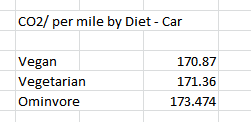Carbon Footprint of Cycling per Mile - Intro
Many basic graphs that compare cycling with other modes of transport rate cycling as "zero" impact.
This is fine as like walking cycling is one of the lowest carbon forms of transport available. However, when we consider the fuel that the cyclist uses i.e. the food they eat in order to gain the calories burnt in cycling does this change anything?
Carbon Footprint of Cycling per Mile - grams of CO2 per mile for a Car
Our benchmark for our CO2 per mile will be that described in "The Ecologist" of 168g/CO2/mile, for a car.
Carbon Footprint of Cycling per Mile - grams of CO2 per mile for a Bicycle
Now consider the calories burnt cycling 1 mile on a Bicycle, this varies base don the speed and the weight of the rider, but a conservative figure might be 50 calories per mile. How does the cyclist get those calories . . . ?
Eating meat, is carbon intensive. . . a meat rich diet creates over double the CO2 footprint of a vegan diet.
So if we we were to cycle 1 mile on a vegan diet, vegetarian or "all in" dirt we would create different emissions.
 |
| gCO2 per mile by Diet |
So if we then apply our 50 calorie per mile number to the CO2 per calorie we get:
 |
| CO2 per mile by diet - Bicycle |
Remember a mile in a car creates 168 gCO2, from burning fossil fuels.
Carbon Footprint of Cycling per Mile - Making a Comparison
Now the average person burns 68 calories per hour whilst sitting. On a single carriage way the driver of a car will burn 1.4 calories per mile. So we can add this CO2 burden to that produced by the fuel. Sp if we add in the metabolic co2 impacts we get.
 |
| CO2 per mile by diet - Car |
Carbon Footprint of Cycling per Mile - Conclusion
Cycling would appear to only save carbon if you eat a low meat diet. Please note this post is restricted to operational impacts only, and does not consider manufacturing impacts or infrastructure impacts.

No comments:
Post a Comment